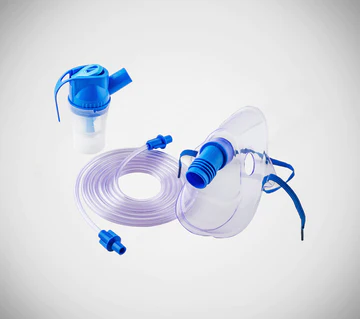A nebulizer mask, often referred to as a “neb mask,” is a medical device used to deliver aerosolized medication to patients, primarily those with respiratory conditions such as asthma, chronic obstructive pulmonary disease (COPD), or respiratory infections. This mask plays a crucial role in facilitating the efficient and targeted administration of inhaled medications. Here’s a description of a nebulizer mask:
Description of a Nebulizer Mask:
A nebulizer mask is a specially designed face mask connected to a nebulizer machine or device. It is typically made of medical-grade materials such as PVC or silicone to ensure safety and comfort during use. Key components of a nebulizer mask include:
- Mask: The central part of the nebulizer mask is the face mask itself, which covers the nose and mouth of the patient. The mask is designed to create an airtight seal, ensuring that the aerosolized medication is inhaled effectively.
- Elastic Head Strap: The mask features an elastic head strap that is adjustable to secure the mask comfortably on the patient’s face. This strap helps keep the mask in place during the nebulization process, allowing the patient to breathe in the medication without interruptions.
- Exhalation Ports: Many nebulizer masks have exhalation ports or valves that allow exhaled air to escape from the mask. These ports ensure that the patient does not rebreathe exhaled carbon dioxide and maintain a constant flow of fresh air.
- Connector Tubing: The nebulizer mask is connected to the nebulizer machine or device through a flexible, transparent tubing system. The tubing delivers the aerosolized medication from the nebulizer to the mask.
How a Nebulizer Mask Works:
- Medication Preparation: The prescribed medication, often in the form of a liquid or aerosol solution, is loaded into the nebulizer chamber of the nebulizer machine.
- Attachment: The nebulizer mask is securely attached to the nebulizer machine using the connector tubing.
- Mask Placement: The mask is placed over the patient’s nose and mouth, ensuring a snug and comfortable fit.
- Nebulization: The nebulizer machine generates a fine mist or aerosol of the medication, which is delivered into the mask through the tubing.
- Inhalation: The patient breathes normally while inhaling the aerosolized medication through the nebulizer mask. The medication is then delivered directly to the airways and lungs, providing relief from respiratory symptoms.
- Completion: Once the prescribed dosage is delivered, the nebulizer mask is removed, and any remaining medication is disposed of or saved for future use.
Applications:
Nebulizer masks are widely used in clinical and home healthcare settings to administer inhaled medications to patients with respiratory conditions. They are particularly beneficial for:
- Asthma Management: Nebulizer masks are used to deliver bronchodilators and anti-inflammatory medications to relieve asthma symptoms.
- COPD Treatment: Patients with COPD often use nebulizer masks to receive medications that help open their airways and reduce symptoms.
- Respiratory Infections: Nebulizer masks are employed to provide antibiotics and other respiratory medications to individuals with respiratory infections.
- Pediatric Care: Nebulizer masks are suitable for children who may have difficulty using inhalers effectively.






